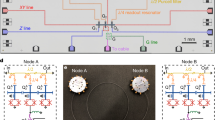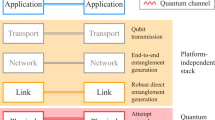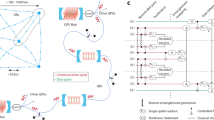Abstract
Large-scale quantum networks promise to enable secure communication, distributed quantum computing, enhanced sensing and fundamental tests of quantum mechanics through the distribution of entanglement across nodes1,2,3,4,5,6,7. Moving beyond current two-node networks8,9,10,11,12,13 requires the rate of entanglement generation between nodes to exceed the decoherence (loss) rate of the entanglement. If this criterion is met, intrinsically probabilistic entangling protocols can be used to provide deterministic remote entanglement at pre-specified times. Here we demonstrate this using diamond spin qubit nodes separated by two metres. We realize a fully heralded single-photon entanglement protocol that achieves entangling rates of up to 39 hertz, three orders of magnitude higher than previously demonstrated two-photon protocols on this platform14. At the same time, we suppress the decoherence rate of remote-entangled states to five hertz through dynamical decoupling. By combining these results with efficient charge-state control and mitigation of spectral diffusion, we deterministically deliver a fresh remote state with an average entanglement fidelity of more than 0.5 at every clock cycle of about 100 milliseconds without any pre- or post-selection. These results demonstrate a key building block for extended quantum networks and open the door to entanglement distribution across multiple remote nodes.
This is a preview of subscription content, access via your institution
Access options
Access Nature and 54 other Nature Portfolio journals
Get Nature+, our best-value online-access subscription
$29.99 / 30 days
cancel any time
Subscribe to this journal
Receive 51 print issues and online access
$199.00 per year
only $3.90 per issue
Buy this article
- Purchase on Springer Link
- Instant access to full article PDF
Prices may be subject to local taxes which are calculated during checkout




Similar content being viewed by others
Change history
26 June 2018
Change history: In this Letter, the received date should be 20 December 2017, instead of 27 April 2018. This has been corrected online.
References
Kimble, H. J. The quantum internet. Nature 453, 1023–1030 (2008).
Broadbent, A., Fitzsimons, J. & Kashefi, E. Universal blind quantum computation. In 50th Annual IEEE Symposium on Foundations of Computer Science 517–526 (IEEE, 2009).
Jiang, L. et al. Quantum repeater with encoding. Phys. Rev. A 79, 032325 (2009).
Ekert, A. & Renner, R. The ultimate physical limits of privacy. Nature 507, 443–447 (2014).
Gottesman, D., Jennewein, T. & Croke, S. Longer-baseline telescopes using quantum repeaters. Phys. Rev. Lett. 109, 070503 (2012).
Nickerson, N. H., Fitzsimons, J. F. & Benjamin, S. C. Freely scalable quantum technologies using cells of 5-to-50 qubits with very lossy and noisy photonic links. Phys. Rev. X 4, 041041 (2014).
Kómár, P. et al. A quantum network of clocks. Nat. Phys. 10, 582–587 (2014).
Hucul, D. et al. Modular entanglement of atomic qubits using photons and phonons. Nat. Phys. 11, 37–42 (2015).
Hensen, B. et al. Loophole-free Bell inequality violation using electron spins separated by 1.3 kilometres. Nature 526, 682–686 (2015).
Kalb, N. et al. Entanglement distillation between solid-state quantum network nodes. Science 356, 928–932 (2017).
Reiserer, A. & Rempe, G. Cavity-based quantum networks with single atoms and optical photons. Rev. Mod. Phys. 87, 1379–1418 (2015).
Hofmann, J. et al. Heralded entanglement between widely separated atoms. Science 337, 72–75 (2012).
Northup, T. & Blatt, R. Quantum information transfer using photons. Nat. Photon. 8, 356–363 (2014).
Pfaff, W. et al. Unconditional quantum teleportation between distant solid-state quantum bits. Science 345, 532–535 (2014).
Monroe, C. et al. Large-scale modular quantum-computer architecture with atomic memory and photonic interconnects. Phys. Rev. A 89, 022317 (2014).
Pant, M. et al. Routing entanglement in the quantum internet. Preprint at https://arxiv.org/abs/1708.07142 (2017).
Schoute, E., Mancinska, L., Islam, T., Kerenidis, I. & Wehner, S. Shortcuts to quantum network routing. Preprint at https://arxiv.org/abs/1610.05238 (2016).
Stockill, R. et al. Phase-tuned entangled state generation between distant spin qubits. Phys. Rev. Lett. 119, 010503 (2017).
Delteil, A. et al. Generation of heralded entanglement between distant hole spins. Nat. Phys. 12, 218–223 (2016).
Bar-Gill, N., Pham, L. M., Jarmola, A., Budker, D. & Walsworth, R. L. Solid-state electronic spin coherence time approaching one second. Nat. Commun. 4, 1743 (2013).
Cabrillo, C., Cirac, J. I., Garca-Fernández, P. & Zoller, P. Creation of entangled states of distant atoms by interference. Phys. Rev. A 59, 1025–1033 (1999).
Minář, J., de Riedmatten, H., Simon, C., Zbinden, H. & Gisin, N. Phase-noise measurements in long-fiber interferometers for quantum-repeater applications. Phys. Rev. A 77, 052325 (2008).
Casabone, B. et al. Heralded entanglement of two ions in an optical cavity. Phys. Rev. Lett. 111, 100505 (2013).
Sipahigil, A. et al. An integrated diamond nanophotonics platform for quantum-optical networks. Science 354, 847–850 (2016).
Robledo, L. et al. High-fidelity projective read-out of a solid-state spin quantum register. Nature 477, 574–578 (2011).
Fuchs, G. D., Dobrovitski, V. V., Toyli, D. M., Heremans, F. J. & Awschalom, D. D. Gigahertz dynamics of a strongly driven single quantum spin. Science 326, 1520–1522 (2009).
Abobeih, M. H. et al. One-second coherence for a single electron spin coupled to a multi-qubit nuclear-spin environment. Preprint at https://arxiv.org/abs/1801.01196 (2018).
Chou, C.-W. et al. Functional quantum nodes for entanglement distribution over scalable quantum networks. Science 316, 1316–1320 (2007).
Matsukevich, D. N. et al. Deterministic single photons via conditional quantum evolution. Phys. Rev. Lett. 97, 013601 (2006).
Maurer, P. C. et al. Room-temperature quantum bit memory exceeding one second. Science 336, 1283–1286 (2012).
Yang, S. et al. High-fidelity transfer and storage of photon states in a single nuclear spin. Nat. Photon. 10, 507–511 (2016).
Riedel, D. et al. Deterministic enhancement of coherent photon generation from a nitrogen-vacancy center in ultrapure diamond. Phys. Rev. X 7, 031040 (2017).
Wan, N. H. et al. Efficient extraction of light from a nitrogen-vacancy center in a diamond parabolic reflector. Preprint at https://arxiv.org/abs/1711.01704 (2017).
Reiserer, A. et al. Robust quantum-network memory using decoherence-protected subspaces of nuclear spins. Phys. Rev. X 6, 021040 (2016).
Aslam, N., Waldherr, G., Neumann, P., Jelezko, F. & Wrachtrup, J. Photo-induced ionization dynamics of the nitrogen vacancy defect in diamond investigated by single-shot charge state detection. New J. Phys. 15, 013064 (2013).
Acknowledgements
We thank S. van Dam, M. Abobeih, T. Taminiau, F. Rozpedek, K. Goodenough and S. Wehner for discussions. We acknowledge support from the Netherlands Organisation for Scientific Research (NWO) through a VICI grant and from the European Research Council through a Starting Grant and a Synergy Grant.
Reviewer information
Nature thanks D. Englund, J. Laurat and the other anonymous reviewer(s) for their contribution to the peer review of this work.
Author information
Authors and Affiliations
Contributions
P.C.H., N.K. and J.P.J.M. prepared the experimental apparatus. P.C.H. and N.K. carried out the experiments. R.F.L.V. and R.N.S. conceived the microwave switch circuit. P.C.H. analysed the data and wrote the manuscript with input from N.K. and R.H. The diamond substrates were grown by D.J.T. and M.M. The project was supervised by R.H.
Corresponding author
Ethics declarations
Competing interests
The authors declare no competing interests.
Additional information
Publisher’s note: Springer Nature remains neutral with regard to jurisdictional claims in published maps and institutional affiliations.
Extended data figures and tables
Extended Data Fig. 1 Deterministic entanglement-delivery sequences.
Pulse sequences for each step of the deterministic entanglement delivery protocol are shown. These sequences are also used in the single-photon entanglement-generation experiment. (1) Optical phase stabilization. Bright light is input to measure and stabilize the interferometer (see Methods). The duration is different for the single-photon entanglement experiment. (2) NV-centre state check. By shining in two lasers that are together resonant with transitions from all of the ground states, the NV centre will fluoresce regardless of its ground-state occupation. By counting photons emitted by the NV centre we can verify that both NV centres are in the desired charge state NV− and that they are on resonance with the applied lasers. The NV centre is deemed to be on resonance if the number of photons detected during the charge/resonance check surpasses a certain threshold. If no photons are detected, then the NV centre is assumed to be in the NV0 state and a resonant laser is applied to reset it to NV−. (3) Heralded single-photon entanglement generation. Entanglement generation proceeds by optically re-pumping the spins to \(\left|\uparrow \right\rangle \) (including passive charge-state stabilization; see Methods) before a microwave (MW) pulse is used to create the desired bright-state population α at each node. A resonant excitation pulse then generates spin–photon entanglement. A subsequent microwave π pulse is used to ensure that the NV-centre state is refocused before the next stage should success be heralded. (4) Dynamical decoupling. Microwave pulses are used to implement dynamical decoupling (see Methods). (5) Single-shot readout. The NV-centre nodes can be read out in arbitrary bases in a single shot. If required, a microwave pulse is applied to rotate the qubit state before a resonant laser is applied. Fluorescence photons from the NV centre are detected if it is in the state \(\left|\uparrow \right\rangle \).
Extended Data Fig. 2 Flowchart of the experimental sequences.
The decision trees of the ADwin microprocessors (Jaeger ADwin Pro II) that create the overarching measurement and control loops for network nodes A and B are shown. Both nodes use arbitrary-waveform generators (AWGs) for microwave and laser pulse sequencing (Tektronix AWG5014C). We additionally use a complex programmable logic device (CPLD) to herald the successful generation of an entangled state in real time (described further in Methods). a, Decision tree when benchmarking the entangled state. b, Deterministic entanglement delivery. Here the ADwin microprocessors keep track of the time since the end of the phase stabilization (t = 0). ‘CR check’: as explained in Extended Data Fig. 1, the NV centre is deemed to be on resonance with the excitation lasers if the number of photons detected during the charge/resonance check surpasses a certain threshold (nph > thr); this is repeated until the threshold is passed. ‘comm.’ and ‘comm. timeout’: both ADwin microprocessors exchange classical communication, such as the success of the charge/resonance check, via a three-step-handshake; if one microprocessor waits longer than 1 ms for a response from its counterpart, then the communication times out and we return to the previous logical step (arrow). ‘Count attempts’: the number of entangling attempts N are counted until N = Nmax. ‘Count dec. time’: the time since phase stabilization is tracked; if the time is equal to the pre-specified state-generation time tgen, then the AWG is triggered and the local readout sequences are executed. ‘Wait for basis rot.’: ADwin microprocessors wait for a trigger input from the AWG (‘AWG done’), which indicates that the last microwave rotation before optical readout has been completed. ‘Trigger AWGs’: the microprocessor of node A triggers the AWGs of both nodes to initiate the microwave and entangling sequences; we use a single microprocessor as the trigger source to avoid timing jitter between both generated sequences. ‘SSRO’: optical single-shot readout. ‘Suc.: Trig. from CPLD’ and ‘Fail: Trigger from AWG’: during entanglement generation, the CPLD communicates successful detection of a photon to the nodes; during the single-photon entanglement-benchmarking experiment, the AWG at each node flags failure of the round after 250 entangling attempts. ‘Do stabilize?’: The microprocessors communicate that phase stabilization will be the next step in the experimental sequence; the microprocessor at node A then proceeds with the phase stabilization while that at node B waits until the phase stabilization has finished. The deterministic entangling sequence is run a total of 1,500 times (500 times per readout basis) before a new round is called in, which starts again with the verification of resonant conditions for both NV centres.
Extended Data Fig. 3 Temporal filtering of photons.
Histograms are shown of the times at which photons are detected at each single-photon detector (blue) during a deterministic entanglement-delivery experiment with bright-state population α = 0.12. The orange histograms show the photons that were detected within the temporal filter window and so were counted as valid entanglement events. The green line shows a Gaussian fit to the pulse with a full-width at half-maximum of 2.26 ns as measured in Extended Data Fig. 8. This is used to estimate the contribution of residual pulse photons within the filter window.
Extended Data Fig. 4 Comparison of experimental model and data.
Including a 3% source of infidelity in our model (which otherwise consists only of independently determined parameters) is sufficient to account for the offset observed between our model and our experimental data. a, The modified model, plotted with experimental data reproduced from Fig. 4. Dashed lines show the model given in the main text (without the infidelity parameter). b, This infidelity also applies to the model shown in Fig. 3, because an equally large number of entanglement repetitions was used in generating the data. Error bars for data and shaded model uncertainties are 1 s.d.
Extended Data Fig. 5 Verifying passive charge-state stabilization into NV−.
a, Elementary sequence to probe the NV-centre ionization rate. b, Applying our sequence many times results in decay of the NV-centre readout fidelity due to ionization (error bars represent 1 s.d.; lines show fitted exponential decays as guides to the eye). By exploring the ionization rate for different charge-reset powers, we find an optimal regime in which the spin initialization of NV− is not affected by the additional blue-detuned beam and ionization is effectively mitigated over thousands of trials.
Extended Data Fig. 6 Optical-phase stabilization.
Single-photon entanglement requires that the optical phase of an effective interferometer between the two nodes is known. a, A typical trace of the interferometer optical phase as it is tracked passively for 2 s. b, Power spectrum of the optical-phase signal, showing peaks thought to be due to mechanical resonances of components in the set-up. c, Active phase stabilization is used to correct for phase drifts. Here the phase is stabilized and then the interferometer is allowed to passively drift for 2 s. The standard deviation of the phase as a function of time is plotted for a dataset of 100 of these measurements. The orange line shows a linear fit, used to estimate the rate of phase drift νint ≈ 20° s−1. d, Here the phase is repeatedly actively stabilized every 180 ms. Entanglement generation occurs during the periods in between stabilization. The interferometer phase is measured directly after each successful heralded entanglement event. e, Histogram of the measured post-entanglement optical phases (blue). A Gaussian fit with a standard deviation fixed to the average measured standard deviation for all entanglement data taken, σint = 14.3(3)°, is also plotted (orange).
Extended Data Fig. 7 Two-photon quantum interference.
a, Histogram for coincident events measured by two single-photon detectors in a two-photon quantum interference experiment, measured by cross-referencing photon detection events from a pulse train of 10 optical π pulses that excite both emitters. Hong–Ou–Mandel interference of simultaneously coinciding photons ideally results in vanishing coincidence events within a single excitation round. The time difference between individual excitation rounds is 1 μs. Histograms of coincidence counts are shown with a bin-size of 5 ns. b, Total number of coincidences as a function of the number of pulses separating the two detection events. We extrapolate the measured coincidences to infer the expected coincidences for distinguishable photons at zero pulse difference by fitting a linear regression (orange). Using this to normalize the 22 observed coincidences for zero pulse difference allows us to estimate the two-photon quantum interference visibility V = 0.90(2). Error bars are 1 s.d.
Extended Data Fig. 8 Width of the optical π pulse.
We find a full-width at half-maximum of 2.26 ns. This measurement is necessary to compute the dual-excitation probability (Extended Data Table 1), given a radiative lifetime of 12 ns. Error bars are 1 s.d.
Extended Data Fig. 9 Determining the optimal inter-pulse delay for state storage and 1,024 inversion pulses.
We initialize a superposition state on the NV-centre electron spin, preserve it via dynamical decoupling and finally perform optical readout after another π/2 pulse. We probe the coherence of the NV centre by varying the inter-pulse delay t in steps of the Larmor period 1/νL ≈ 2.25 μs and shifting the delay in steps of 4 ns for a total of five data points per Larmor period (grey). For each multiple of the Larmor period we pick the best (the most preserving) inter-pulse delay (blue). We determine the optimal delay t by selecting an inter-pulse delay that provides sufficient state preservation (about 100 ms) for a moderate number of pulses (red data point and inset text). Left, node A; right, node B. Error bars are 1 s.d.
Rights and permissions
About this article
Cite this article
Humphreys, P.C., Kalb, N., Morits, J.P.J. et al. Deterministic delivery of remote entanglement on a quantum network. Nature 558, 268–273 (2018). https://doi.org/10.1038/s41586-018-0200-5
Received:
Accepted:
Published:
Issue Date:
DOI: https://doi.org/10.1038/s41586-018-0200-5
This article is cited by
-
Donor-acceptor pairs in wide-bandgap semiconductors for quantum technology applications
npj Computational Materials (2024)
-
Quantum networks with neutral atom processing nodes
npj Quantum Information (2023)
-
Optimal entanglement distribution policies in homogeneous repeater chains with cutoffs
npj Quantum Information (2023)
-
Ultra-narrow inhomogeneous spectral distribution of telecom-wavelength vanadium centres in isotopically-enriched silicon carbide
Nature Communications (2023)
-
Programmable photonic integrated meshes for modular generation of optical entanglement links
npj Quantum Information (2023)
Comments
By submitting a comment you agree to abide by our Terms and Community Guidelines. If you find something abusive or that does not comply with our terms or guidelines please flag it as inappropriate.



